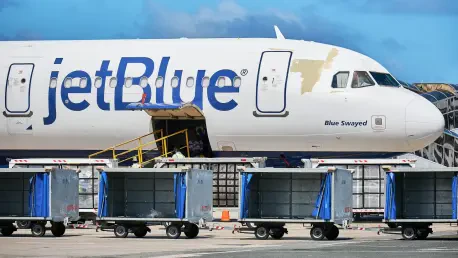Imagine boarding a flight and connecting to Wi-Fi that rivals the speed and reliability of your home internet, streaming movies or joining video calls without a glitch at 30,000 feet. This vision is inching closer to reality with the groundbreaking partnership between JetBlue, a prominent U.S. airline, and Amazon’s Project Kuiper, a low Earth orbit (LEO) satellite network designed to revolutionize global connectivity. Announced this year, their collaboration aims to turbocharge JetBlue’s Fly-Fi service, promising passengers an unparalleled online experience while reshaping the landscape of in-flight internet.
This alliance is more than a tech upgrade; it’s a strategic move in a $10 billion satellite broadband market hungry for innovation. With plans to equip 25% of its fleet—about 70 aircraft—with Kuiper’s cutting-edge terminals by 2027, JetBlue is betting on a hybrid model that blends LEO and traditional geostationary (GEO) systems to eliminate issues like signal loss over remote areas. Meanwhile, Amazon’s ambitious $10 billion project, involving over 3,200 satellites, positions it as a serious contender against rivals, extending its reach into aviation and beyond. The implications of this partnership could redefine air travel connectivity and set new industry standards.
The Strategic Alliance
JetBlue’s Vision for Connectivity
JetBlue has long prioritized passenger satisfaction, and its decision to integrate Amazon Kuiper’s LEO satellite technology marks a significant step toward redefining in-flight internet. This initiative isn’t merely about faster browsing speeds; it’s a calculated effort to address persistent connectivity challenges, such as dropped signals during transoceanic flights. By adopting a system that promises lower latency and higher bandwidth, the airline seeks to create a seamless digital experience for travelers, whether they’re streaming content or working remotely. This move aligns with JetBlue’s broader JetForward strategy, which emphasizes customer-centric innovation while optimizing operational efficiency. If successful, it could solidify the airline’s reputation as a leader in aviation technology, appealing to a growing demographic of tech-savvy passengers who view reliable Wi-Fi as a non-negotiable amenity.
Beyond enhancing the passenger experience, JetBlue’s early adoption of this technology signals a commitment to staying ahead in a fiercely competitive market. The plan to outfit a significant portion of its fleet with Kuiper’s aviation-grade terminals by 2027 demonstrates a forward-thinking approach to infrastructure investment. This isn’t just a reaction to current trends but a proactive stance to shape future expectations around in-flight services. By potentially offering free or highly affordable Wi-Fi, JetBlue could differentiate itself from competitors burdened by slower, more expensive systems. Such a strategy might not only boost customer loyalty but also attract corporate clients who rely on consistent connectivity for business travel, positioning the airline as an innovator in a space where technology and hospitality intersect.
Amazon’s Expansion into Aviation
Amazon’s Project Kuiper represents a bold venture into the realm of global connectivity, and its partnership with JetBlue serves as a critical entry point into the aviation sector. This $10 billion initiative, aimed at deploying a vast network of LEO satellites, is designed to provide high-speed internet across diverse industries, from remote terrestrial regions to air travel. By aligning with JetBlue, Amazon gains a real-world testing ground to refine its technology for aviation-specific challenges, such as maintaining stable connections at high altitudes and speeds. This collaboration diversifies Amazon’s portfolio beyond e-commerce and cloud computing, tapping into a niche yet scalable market with significant growth potential. It’s a strategic step to establish Kuiper as a formidable player in the satellite broadband ecosystem.
The implications of Amazon’s move into aviation extend far beyond a single airline partnership. Success with JetBlue could open doors to other sectors like maritime and defense, where demand for reliable, high-speed connectivity is equally pressing. Kuiper’s focus on affordability—offering user terminals at under $400—sets it apart in an industry often criticized for high costs, potentially disrupting traditional pricing models. This cost-effective approach could appeal to a wide range of airlines and industries, amplifying Amazon’s influence in the connectivity space. Moreover, by challenging established competitors through innovation and strategic alliances, Amazon positions itself to capture a substantial share of a market projected to grow rapidly over the coming years, reshaping how connectivity solutions are developed and deployed globally.
Market Dynamics and Competitive Edge
Booming Satellite Broadband Industry
The satellite broadband market is experiencing explosive growth, with projections estimating an expansion to $22.6 billion by 2030, driven by an insatiable demand for high-speed internet across aviation, maritime, and remote regions. This surge reflects a broader societal shift toward constant connectivity, where passengers expect the same digital access in the sky as they do on the ground. JetBlue’s collaboration with Amazon Kuiper taps directly into this trend, leveraging LEO satellite technology to deliver superior performance compared to older GEO systems. Unlike traditional setups that suffer from high latency, LEO networks offer near-instantaneous data transmission, making them ideal for real-time applications like video conferencing or live streaming. This partnership exemplifies how airlines and tech companies can align to meet evolving consumer needs in a landscape ripe for disruption.
This booming industry isn’t just about meeting demand; it’s also a battleground for technological supremacy among major players. The race to provide faster, more reliable internet has intensified as satellite networks expand their global reach, covering areas previously deemed inaccessible. For JetBlue, partnering with Kuiper means gaining access to a cutting-edge solution that could redefine service standards in aviation. Meanwhile, Amazon benefits from positioning itself at the forefront of this growth wave, using aviation as a springboard to explore other high-demand sectors. As the market continues to evolve, collaborations like this one highlight the critical role of innovation in addressing connectivity gaps, ensuring that even the most remote corners of the world—or the skies above them—stay linked to the digital ecosystem.
JetBlue’s Competitive Advantage
JetBlue’s decision to adopt Kuiper’s technology early on provides a distinct edge in an industry where customer expectations are rapidly shifting toward seamless digital experiences. By integrating a system that promises faster speeds and fewer interruptions, the airline can offer a Wi-Fi service that stands out against competitors still reliant on outdated, costlier GEO-based solutions. This isn’t merely a technical upgrade but a potential game-changer in how passengers perceive value during air travel. If JetBlue can deliver on the promise of free or low-cost, high-quality internet, it might attract a broader customer base, from leisure travelers binge-watching shows to business professionals needing reliable connections for work. Such a move could pressure rival airlines to rethink their own connectivity offerings, sparking a wider industry shift.
The competitive advantage extends beyond passenger appeal to operational and branding benefits for JetBlue. Being among the first to harness LEO satellite technology reinforces the airline’s image as an innovator, a reputation that can translate into long-term loyalty and market share gains. Additionally, the hybrid LEO-GEO model planned for implementation by 2027 aims to ensure comprehensive coverage, even over challenging terrains like oceans or polar routes where signal dropouts are common. This reliability could become a key differentiator, especially for routes where competitors struggle to maintain service quality. As the aviation sector becomes increasingly tied to technological advancements, JetBlue’s proactive stance in this partnership positions it to lead rather than follow, potentially setting a new benchmark for what passengers expect from in-flight connectivity.
Challenges and Risks
Navigating Potential Roadblocks
While the JetBlue-Kuiper partnership holds immense promise, it faces significant challenges that could hinder its ambitious timeline. Financial details of the deal remain opaque, creating uncertainty about cost-sharing and profitability for both parties. Regulatory constraints add another layer of complexity, with mandates like the FCC’s requirement for half of Kuiper’s satellite constellation to be operational by mid-2026 looming large. Failure to meet such deadlines could delay the entire project, impacting JetBlue’s rollout plans for 2027. Additionally, the technical intricacies of integrating LEO terminals into existing aircraft systems pose logistical hurdles, from ensuring compatibility to managing installation downtime. These roadblocks demand meticulous planning and coordination to avoid setbacks that could undermine confidence in the partnership’s potential.
Beyond regulatory and technical issues, external factors could also disrupt progress. Market volatility or shifts in satellite broadband competition might affect funding or strategic priorities for Amazon, potentially slowing Kuiper’s development. For JetBlue, any delays in deployment could frustrate passengers expecting immediate improvements, risking reputational damage in a highly visible industry. Both companies must also contend with unforeseen challenges, such as supply chain disruptions for satellite components or geopolitical tensions affecting launch schedules. Navigating this complex web of obstacles requires not only technical expertise but also strategic foresight to anticipate and mitigate risks. The success of this alliance hinges on the ability to address these challenges head-on, ensuring that the vision of transformed in-flight connectivity doesn’t stall before takeoff.
Long-Term Implications
The long-term implications of this partnership extend well beyond the immediate goal of enhancing JetBlue’s Wi-Fi capabilities. A successful rollout could serve as a catalyst for similar alliances across the aviation industry, encouraging other airlines to explore LEO satellite technology to remain competitive. This might accelerate the adoption of next-generation connectivity solutions, fundamentally altering how air travel integrates digital services. For Amazon, proving the viability of Kuiper in aviation could unlock opportunities in adjacent sectors like maritime or defense, where reliable internet is equally critical. However, any significant setbacks—whether technical failures or missed deadlines—might cool enthusiasm for such cross-industry collaborations, slowing the momentum of LEO technology’s integration into everyday travel.
Another critical aspect to consider is the broader impact on industry standards and consumer expectations. If JetBlue and Kuiper deliver on their promise of superior connectivity, it could raise the bar for what passengers demand from all airlines, pushing the sector toward a connectivity-first mindset. Conversely, persistent challenges or underwhelming performance might reinforce skepticism about the practicality of satellite-based solutions in aviation, giving an edge to competitors with alternative strategies. The stakes are high for both JetBlue’s brand as a customer-focused innovator and Amazon’s ambitions to dominate the satellite broadband market. The outcome of this venture will likely influence not just their trajectories but also the direction of technological integration in travel for years to come, shaping policies, investments, and partnerships.
Industry Trends and Future Outlook
Convergence of Tech and Travel
A defining trend in modern aviation is the growing intersection of technology and travel, where digital connectivity has become as essential as comfort or safety for many passengers. The alliance between JetBlue and Amazon Kuiper embodies this shift, highlighting how airlines are increasingly reliant on tech solutions to meet consumer demands for always-on internet access. LEO satellite networks, with their ability to provide low-latency, high-speed connections, stand out as a transformative force compared to the limitations of traditional GEO systems. This technology enables real-time interactions, from live social media updates to virtual business meetings, directly from the sky. As this convergence accelerates, it’s clear that partnerships like this one are not just enhancements but necessities for airlines aiming to stay relevant in a hyper-connected world.
This blending of sectors also reflects a broader cultural expectation that connectivity should be ubiquitous, regardless of location or mode of transport. Passengers no longer see Wi-Fi as a luxury but as a baseline requirement, akin to in-flight meals or entertainment systems. The push for LEO-based solutions by JetBlue and Kuiper addresses this shift, offering global coverage that could eliminate dead zones over oceans or remote areas. Such advancements might redefine travel experiences, making long-haul flights more productive or entertaining. Moreover, this trend signals a future where tech giants play a larger role in shaping travel infrastructure, blurring the lines between industries. As consumer needs evolve, the ability to integrate cutting-edge technology will likely become a key differentiator for airlines, with this partnership serving as a pioneering example of what’s possible.
Setting a Precedent for Innovation
The collaboration between JetBlue and Amazon Kuiper has the potential to establish a powerful precedent for how cross-industry partnerships can drive innovation in aviation and beyond. If the rollout succeeds, with enhanced Wi-Fi transforming passenger experiences by 2027, it could inspire a wave of similar alliances between tech companies and airlines, accelerating the adoption of LEO technology across the sector. This might lead to a ripple effect, where improved connectivity becomes a standard offering rather than a premium feature, fundamentally changing competitive dynamics. For Amazon, a strong performance in aviation could bolster confidence in Kuiper’s applicability to other high-growth areas like maritime logistics or rural broadband, expanding its influence in the global connectivity market.
Looking ahead, the success of this initiative might also encourage regulatory bodies and industry stakeholders to streamline processes for integrating satellite technology into commercial applications. Lessons learned from JetBlue’s implementation—whether related to technical integration or cost management—could inform best practices for future projects, reducing barriers for other players. Even in the face of challenges, the partnership’s outcomes will offer valuable insights into balancing innovation with practicality. Ultimately, this alliance stands as a test case for how bold, collaborative efforts can address modern travel’s digital demands, potentially paving the way for a new era of connectivity-driven progress across multiple industries. Reflecting on past efforts, it’s evident that such pioneering steps often lay the groundwork for widespread transformation, and this venture follows suit with remarkable ambition.









